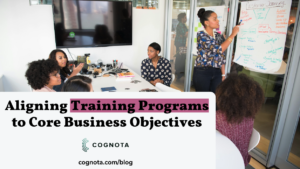Job descriptions for senior L&D professionals often include a requirement that the applicant is eager to stay current and embrace the most cutting-edge learning technologies. This makes sense, as increasingly sophisticated software has transformed industries by using automation and personalization to increase efficiency and reduce costs.
And if L&D professionals create learning for others, it follows that they would want to learn as much as they can for themselves.
But if it ain’t broke, should you fix it?
While bells, whistles, and new shiny objects can serve to stimulate and engage your learners, L&D professionals need to start earlier in the learner’s journey. They need to establish whether learning is even needed, so as to not waste resources.
A mechanism to crowdsource training requests, both formally and informally, is paramount to understanding the needs of individuals, teams, and entire departments — before deciding if some gimmicky ‘solution’ should be added to a training module.
A Learning Design System (LDS) can help. Besides the ability to convert technical content to training material, allowing anyone to design and build effective courses rapidly and at scale, an LDS incorporates automation elements that can streamline your front-end development process. From crowdsourcing training requests to performing a needs analysis, then incorporating design, content assembly, storyboarding, prototyping, testing, version control, and maintenance.
There are 3 steps to ensure the effective crowdsourcing of training ideas:
(1) Create a questionnaire for the intake process. It will help your employees and internal clients digest their high-level needs into something that L&D can understand. Don’t fall for the standard traps of Word documents, PDFs, or email — use a platform that can capture and organize this information properly.
(2) Establish a feedback loop so that you can communicate and collaborate openly with the requester. Let them know that you received the request and what you are doing to help them. Even if training is not the solution, let them know. It is imperative that every voice is heard.
(3) Include employees in the instructional design process. Since they’re the ones closest to the problem, include them in the analysis and design. Ask for their feedback along the way and ask for suggestions for others they know who can participate (i.e. subject matter experts or colleagues). Developing training does not have to be onerous and complicated — it can also be fun. Ask the requester to get involved during the process. For example, they can film some footage on their cell phones with colleagues and peers to help you out.
These seemingly small steps can make a huge impact on the effectiveness of the design, planning, and delivery of your courses.
Companies may hire people based on what they know. But as employees are in a constant state of learning, organizations should be curious to understand more about how their employees acquire and share knowledge to improve job performance. This front-end needs analysis is imperative for the success of a learning initiative.
Rather than chase shiny new objects, today’s L&D leaders need a system that can be tailored to the needs, preferences, and learning styles of learners in their organization.





